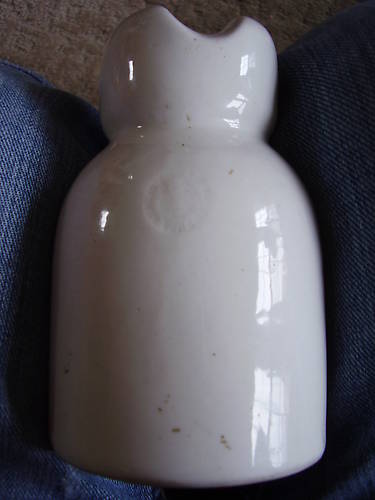Schomburg & Söhne (ca. 1880-1903) porcelain pintype
By Zac Mirecki; posted November 8, 2009
View Original: Click to zoom, then click to magnify (1920 x 2560) 1085KB

|
I have owned this piece for about 4 years and acquired it from the collection of Phil Mayhew. The story goes that Phil found this piece in a Massachusetts antique shop in the late 1960s or early 1970s and owned it until selling it to me. What really attracted me was the marking on the insulator which Phil still affectionately calls a "story on an insulator." German collector Günther Aselmeyer was kind enough, when contacted, to research the marking on this insulator for me. He found information on the marking in the book entitled "Deutsche Porzellanmarken: Von 1710 bis heute" by Richard E. Röntgen in 2004. Although the insulator depicts a workman with a nineteenth century porcelain kiln in the background, the marking in the book had the words "Porzellan-Mühlensteine" (which translates as porcelain mill or grindstones). However the marking on this Schomburg reads "SGHDMBURG BERLIN MOABIT" Schomburg is indeed misspelled and it is also interesting to note that the "O" and "A" in Moabit is one character with no space. Günther elaborates that "According to the book that marking ("Porzellan-Mühlensteine") had been officially registered in 1880. Your insulator had been produced in the town of Moabit, which later became part of fast growing Berlin end of the 19th century. The Schomburg & Söhne factory had been surrounded by other industrial premises and new houses so they could not expand production and had to move to another location in 1903. Therefore your insulator can be dated to a period from ca. 1880 to 1903. I guess it was made between 1875 and 1890. The company has produced millions of such insulators in constant quality, but most from that early period are not marked and cannot be identified or dated. I have a few examples marked with an EAGLE or with SCHOMBURG and the year of production 1892 and 1898. But your example is surely older. A simple embossing inside the outer skirt (usually several parallel scratches) is often found in such insulators made by Schomburg and even more by KPM. It is an internal code indicating the production charge or maybe the person who made or controlled it. I'm afraid there is no chap still alive who could tell us......." The insulator above is also marked with a small "X" on one of the ears as well as what appears to be an "11" on the inside of the outer skirt. This is the marking that Günther alluded to above. We will probably never know how the insulator came to be in a late 1960s antique shop here in the states but Günther elaborated he feels that it is possible a serviceman stationed in Germany brought it home as a souvenir. Thank you Gunther for your wonderful research and, as always, thanks for looking! Best collecting to all. Update: after further research it appears this piece was likely used on William Stanley's transmission line in Great Barrington MA. I had been communication with the grandson of the line foreman who dismantled the original line and he is in possession of the twin, unmarked version, of this insulator. |